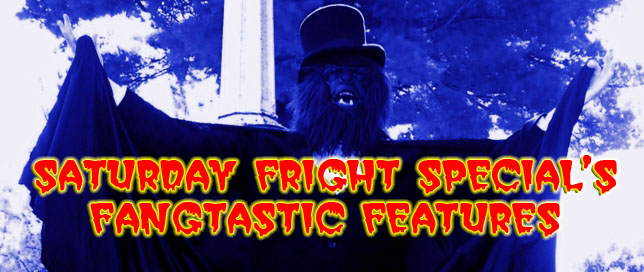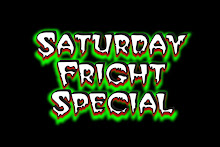
Reviewed by Rick Trottier
When a film maker’s work is collected into some kind of abridged boxed set, like THE DEL TENNEY COLLECTION, on one level it is an opportunity to see similarities and differences of the artist’s craft as well as the vehicles by which his message was delivered. In this case, there is bonus to this compilation. One can sample a retrospective of the kinds of “drive-in” fare that could be had in the early 1960s. While most prolific directors have cinematic canons that often run a lengthy gamut of every genre and style, Del Tenney has a fairly small filmography and to have three such diverse films represented in it, VIOLENT MIDNIGHT, THE HORROR OF PARTY BEACH and THE CURSE OF THE LIVING CORPSE, makes this a must-have for horror lovers, 1960s film buffs and cinemaniacs in general.
VIOLENT MIDNIGHT (1962) is the story of reclusive, war-tormented artist Elliot Freeman and his sister Lynn. Tragedy and insanity have haunted the Freeman family for years, but all Elliot wants to do is paint powerful portraits of beautiful nude models like Dolores. When women start turning up dead in this quiet college town, all evidence seems to point to Elliot. Before long, a web of deceit and desire has a wide variety of townsfolk caught in its clinging cords just at the moment when a knife-wielding maniac is on the loose.
VIOLENT MIDNIGHT splits time between being three film genres and somehow is able to make this strange admixture work. What starts out as a patient, taut suspense-thriller, later transforms into something akin to a detective potboiler grafted onto an exploitation film, and by the end changes back into the suspense-thriller again. When it is a suspenseful, proto-slasher film, it is moody, well shot, enticingly scored with an emotive orchestral soundtrack and engaging. Dick Van Patten adds one of his earliest performances as Lt. Palmer, brusquely and sweatily trying to bring the killer to justice in a “Brett Halliday-like” manner. A very young James Farentino adds brooding looks, a hirsute physique and lots of Brylcreem to the exploitation side of this film, a side seething with nubile young women in various states of undress, peeping toms, tawdry romance, fisticuffs and a jazzy, hip soundtrack. If it sounds like a lot going on, it is, but it works on all its fronts, all the way to the “surprise” shocker climax melded with a blissful, romantic denouement. VIOLENT MIDNIGHT does what few exploitation films were every able to do, call itself a well made film complete with an interesting story, good looking actors/actresses, and fine camerawork. There are elements of this film that feel very slightly derivative of its predecessor DEMENTIA 13, but it is likely that the ingredients borrowed were just as much a nod as a nick. VIOLENT MIDNIGHT is a great film to start with in this boxed set because it may be the most complete of the three. It is certainly the best crafted.
HORROR OF PARTY BEACH (1963) is the “tale” of beach-combing he-man/scientist Hank, his party-happy girlfriend Tina, research scientist Dr. Gavin and his lovesick daughter Elaine. Radioactive barrels of waste are dropped off the coast of a New Jersey beach only to break open and spawn two grotesque “fish-monsters” who stomp about town after the only food that can sustain them, human blood. As the body count rises, beach bunnies, lithe lifeguards, belligerent bikers and raucous rock ‘n rollers are scrambling to avoid the fate of ending up as chum.
Those who go into HORROR OF PARTY BEACH expecting a sober and scary film had best restructure their attitudes or they will think they are watching one of the worst pieces of crap ever made. This splendid spoof is saturated with SILLINESS and for that let us be glad. By the end of this send-up of both the “Beach Party” movies and 1950s Sci Fi/monster films, you will be inundated by grins, giggles and outright guffaws. Almost every icon of the early 60s is lampooned from silly dancing, silly pop music, silly fighting, silly dialogue, to silly story twists and especially silly monster costumes. While Del Tenney spoils the surprise in his charming interview in the extras segment, anyone who thought that HORROR OF PARTY BEACH was a serious effort needs to take a chill-pill. What emerges from this movie is a very slick tongue-in-cheek stab at the flagships of drive-in fare. While not the artistic diamond-in-the-rough that VIOLENT MIDNIGHT is, and suffering from some very dark stretches that were either filmed that way or the product of a troubled master and transfer, HORROR OF PARTY BEACH is still a great time waiting for friends who want to sit down with some Jiffy-Pop and smirk ‘til it hurts, not from mocking something old and wacky, but deriving joy from a film meant to funny from the get-go. As the second feature in the pack, HORROR OF PARTY BEACH lightens the mood just enough for the clincher.
Set in New England of 1892, THE CURSE OF THE LIVING CORPSE (1963) is the story of the Sinclair clan, whose patriarch, Rufus Sinclair has just “passed on” and left the ancestral estate and fortune to his “grieving” family. Once the will of Rufus Sinclair is read, it becomes obvious that the family can only claim his money if they abide by a set of macabre legal provisions instituted to insure that Mr. Sinclair was not prematurely buried alive. It is not long before grisly goings-on begin and family members begin falling victim to the curses stated in Rufus’s will, since they did not do his bidding.
THE CURSE OF THE LIVING CORPSE is the most “mainstream” of the Tenney films. It is a whodunit complete with a sinister masked figure, a period piece with Gothic overtones and setting but coupled with a liberal dose of slasher-film essence. There is a young Roy Scheider is his first film role and Candace Hilligoss of CARNIVAL OF SOULS fame in her only other Big Screen performance, both of which are parts of an ensemble cast that give very intense, often beautifully overacted performances that only add to the Regency Romance novel feel of this fun flick. While it is not the tour de force of most European Gothic cinema of that time like BLACK SUNDAY or CASTLE OF BLOOD, it does deliver an atmospheric aura and a tangled tapestry of intrigue and lust that doesn’t skimp on ghastly, gruesome death scenes and predictable yet still satisfying curves in the story map. While being somewhat formulaic despite a surprise arrival of some comedic capers of the inspector and his ludicrous constable, THE CURSE OF THE LIVING CORPSE seems like it is almost a coda, an homage to the Silver Screen Gothic Tale whose days were like sands sliding out of the hourglass throughout the 1960s. By the end of the decade, Europeans were still making Gothic Ghost stories and their like, but the sun had pretty much set on American contributions to that genre. THE CURSE OF THE LIVING CORPSE is an unspectacular but still deeply enjoyable example of a film variety that almost doesn’t exist anymore.
Each film has a small but pleasing extras menu. Every flick comes with a Del Tenney audio commentary. VIOLENT MIDNIGHT and THE CURSE OF THE LIVING CORPSE have photo galleries and theatrical trailers while HORROR OF PARTY BEACH has the afore-mentioned 9 minute interview. While this isn’t the Taj Mahal of extras, it is fairly impressive when you consider that Del Tenney is well-regarded and well-remembered but he is not William Whyler or Elia Kazan. He is a director, producer and writer of three films that have attained a cult following and it is only after watching them that you really understand why.
Taken as a whole THE DEL TENNEY COLLECTION is a walk down a whole set of memory lanes, paths and boulevards. What is nice about this blessed mix of movies is that you can sit down and watch them all, reveling in their time-capsule feel and the way that they paint a mural of what early 60s low-budget films were like. Alternately, you can watch them as best fits your mood, because THE DEL TENNEY COLLECTION spans the spectrum of cinematic emotions. Make sure that you’ve got the right accoutrements and mood amplifiers to accompany your travels. Whether it’s beach attire and 45 singles, or your leather jacket and Wildroot Crème Oil, or an Ascot and a bowl of aspic, getting in the correct frame of mind and then sitting down to these little gems is the right thing to do on a Sunday afternoon or late at night when the urge to go back to a better time grabs hold and there is no way to shake it. Let Del Tenney be your guide. You won’t be sorry.
http://darkskyfilms.com/






